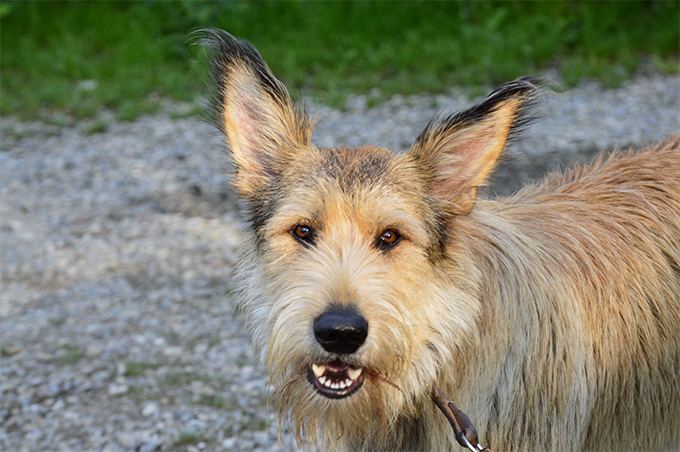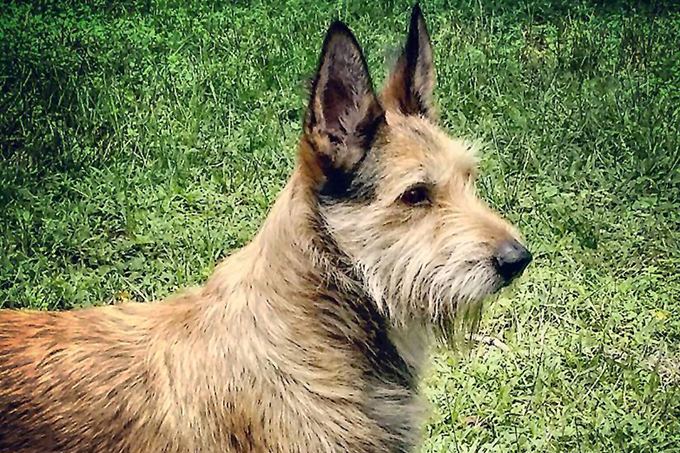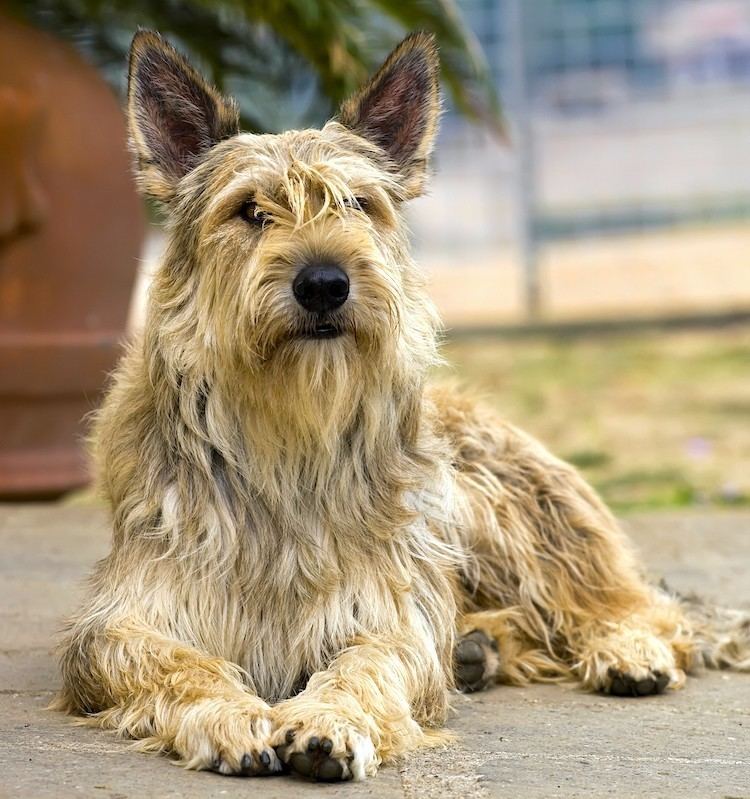Coat rough AKC Herding Lifespan 12 – 13 years Colors Grey, Fawn | Litter size 2–10 pups Herding standard | |
 | ||
Other names PicardBerger de PicardiePicardy ShepherdPicardy Sheepdog FCI Group 1, Section 1 Sheepdogs #176 Temperament Mellow, Lively, Energetic, Stubborn, Intelligent, Assertive Height Male: 60–65 cm, Female: 55–60 cm Weight Male: 23–32 kg, Female: 23–32 kg Similar Pyrenean Shepherd, Bergamasco Shepherd, Briard, Polish Lowland Sheepdog, Cão da Serra de Aires | ||
Meet the berger picard
The Berger Picard (pronounced "Bare-ZHAY Pee-CARR") or Picardy Shepherd is a French breed of dog of the herding group of breeds. Berger is the French word for shepherd and Picardie is the region of France where they originate. Owners and fanciers call them simply Picards. These dogs nearly became extinct after both World War I and World War II and remain a rare breed. This breed of dog is people-oriented, loyal, and can make a good family pet if properly socialized early in life.
Contents
- Meet the berger picard
- Berger picard dog breed
- Appearance
- Temperament
- Health
- Exercise and activities
- Living conditions
- Grooming
- History
- Interesting facts
- Additional reading
- References

The producers of the 2005 American movie Because of Winn-Dixie brought five Picards over from Europe ("Scott", "Laiko" and "Tasha" performed in the movie). The trainer wanted a dog that resembled the scruffy mutt on the original book's cover but needed several that looked alike so that production could continue smoothly, thus he decided on this rare purebred dog from France. It is this breed's rustic mutt-like appearance that has prevented it from being rapidly popularized and exploited in the United States by the movie release, as has been the fate of some other breeds. People often mistakenly think "Winn-Dixie" is a mixed breed.

Like any breed of dog, the Picardy Shepherd is not for everyone, and much thought must be devoted to choosing the right dog. As more Picard puppies are imported into the US from France and other countries, it is important that owners and future breeders remain responsible; they will determine the fate of this breed in the United States. In 2006 the Berger Picard Club of America was formed to help promote and protect this breed. The Berger Picard was fully recognized in the herding group by the American Kennel Club as of 1 July 2015.

Berger picard dog breed
Appearance

The Berger Picard is a medium-sized, well-muscled dog, slightly longer than tall with a tousled yet elegant appearance. Their ears are naturally erect, high-set and quite wide at the base. Their eyebrows are thick, but do not shield their dark frank eyes. They are known for their smile. Their natural tail normally reaches to the hock and is carried with a slight J-curve at the tip. Their weather-proof coat is harsh and crisp to the touch, not excessively long with a minimal undercoat. Coat colors fall into two colors, fawn and brindle with a range of shade variations.
Temperament
The Berger Picard's attributes include a lively, intelligent personality and a sensitive and assertive disposition that responds quickly to obedience training. By and large, Picards are laid back and mellow but they are known for having a stubborn streak and being reserved towards strangers. They require a lot of socialization during the first two years of their lives.
Picards are energetic and hard working, alert and are not excessive barkers. Some Picards are notoriously picky eaters, and it may be difficult to decide on a diet that you and the dog agree on.
The breed also has a well-developed sense of humor, making them an endearing companion, and they continue to be used very effectively as both sheep and cattle herder in their native land and elsewhere.
Like many herding breeds, Picards require human companionship and lots of it. Since they can be demonstrative to their owners and enthusiastic friends towards other animals, formal obedience training and plenty of positive socialization is a must. Athletic, loyal and filled with a desire to work a long day, the breed excels in any "job" as long as enthusiasm and praise is a part of the task.
Health
Berger Picards due to lack of over breeding are a relatively healthy breed. Hip dysplasia is known, as are several eye disorders, including progressive retinal atrophy or PRA. A reputable breeder will have hips certified by the Orthopedic Foundation for Animals (OFA) or by PennHip with the results posted at the OFA database. Eyes will be certified for hereditary diseases through the OFA as well (previously through the Canine Eye Research Foundation) and results should also be published on the OFA database.
The Berger Picard also participates in the Canine Health Information Center. To obtain a CHIC number, dogs must have their hips and eyes checked with the results published on the OFA website and their blood banked for DNA plus one elective, either elbows, thyroid or heart evaluated.
The OFA Berger Picard health survey has been developed in cooperation with the Berger Picard Club of America Health committee and the BPCA Board of Directors to determine health concerns appearing in the Berger Picard. This survey is hosted and managed by the OFA & CHIC, and is completely anonymous. It is designed to gather health information on Picards anywhere in the world, and make the cumulative results available to anyone who wants to see them. No individual dogs are tracked. This is simply to report overall health of as many dogs as possible. With this knowledge, breeders can work toward improving overall health of the breed in future generations. Where warranted, the club will encourage participation in research projects investigating diseases that may appear in the breed.
The breed's life expectancy is 12 to 14 years.
Exercise and activities
Bred to work the fields, Picards are very athletic and revel in exercise. A good deal of exercise is therefore a must for this breed. Otherwise boredom will give way to destructive behavior and rowdy play. They enjoy swimming, running beside a bike, and nice long walks. The Berger Picard makes an excellent jogging companion. The breed's intelligence and sensitivity have made it increasingly popular in dog sports such as agility trials, Tracking, obedience, showmanship, Schutzhund, Flyball, Lure coursing, French Ring Sport and herding events. Herding instincts and trainability can be measured at noncompetitive herding tests. Berger Picards exhibiting basic herding instincts can be trained to compete in herding trials.
Living conditions
Despite being able and ready to work outdoors, Picards can do surprisingly well in city life provided they are given enough energy-releasing exercise. However, the Picard always tries to stay close to its owner and family, so when given a choice between being alone in a big yard or inside with its master the Picard would rather be with his "shepherd." Inside the house the Picard is usually a very quiet dog, waiting for its time to go out to run, play and sniff around. They are very loyal and enjoy a lot of attention and may suffer from separation anxiety (even if being left alone inside for short periods of time). This is not a breed created to live outside year round. They lack the layer of body fat that even a lean Livestock Guardian Dog has and their coat is not dense enough to withstand fridge winter conditions of many areas.
Grooming
The Berger Picard is a low maintenance dog. The rough, tousled coat can mat if not brushed on a regular basis (once every other week) but the coat does not require special care to yield its rustic appearance. Bathing is rarely done. Their fur should never be trimmed except possibly hand-stripping the ears. They do shed but not as much as other breeds. Picards have low oil content in their fur and therefore have little "doggie odor".
History
Thought to be the oldest of the French Sheepdogs, the Berger Picard was brought to northern France and the Pas de Calais, in the 9th century by the Franks.
Some experts insist that this breed is related to the more well-known Briard and Beauceron, while others believe it shares a common origin with Dutch and Belgian Shepherds. Although the Berger Picard made an appearance at the first French dog show in 1863, the breed's rustic appearance did not lead to popularity as a show dog.
The breeding stock of the Berger Picard, was decimated by the ravages of World War I and World War II. With its population concentrated on the farms of north-eastern France, trench warfare in the Somme reduced the breed to near extinction.
The Picard's easy care and mellow, yet mischievous, temperament have started the breed back on the road to recovery. Nevertheless, its numbers are still limited, even in its native country. As mentioned previously, today in France there are approximately 3500 dogs and in Germany approximately 500 of this breed. At present there are approximately 400 Berger Picards in the United States and Canada.
In December 2006, the Berger Picard Club of America was formed to protect and promote the breed in the United States. The Berger Picard has been recorded in the Foundation Stock Service of the American Kennel Club since April 2007. On October 12, 2011, the American Kennel Club chose the Berger Picard Club of America as the official parent club, as the breed moves towards full recognition. At the February 2012 Meeting of the American Kennel Club Board of Directors, the Board voted to move the Berger Picard into the Miscellaneous Group effective January 1, 2013. At the April 22, 2014, The AKC Board voted to approve a request from the Berger Picard Club of America to approve the breed standard submitted as the official breed standard for the Berger Picard breed, move the Berger Picard from the Foundation Stock Service into the Stud Book of the American Kennel Club on June 1, 2015, and approve the Berger Picard to compete in the Herding Group, effective July 1, 2015.
The Berger Picard is a recognized breed by the Canadian Kennel Club. It is in the Herding Group, Group 7. The Standard for this breed is available through the Canadian Kennel Club, Group 7 breed standards. The national breed club is Berger Picard Club Canada.
The interim breed standard for the Picardy Sheepdog was approved and the breed was accepted on to the import register of the United Kingdom's Kennel Club on the 1st April 2014. The breed can only be shown in Import classes at present and currently awaiting official registration of the breed club the Picardy Sheepdog club (proposed). The Picard was first shown at Crufts in March 2016 in the Pastoral (Herding) Group.
